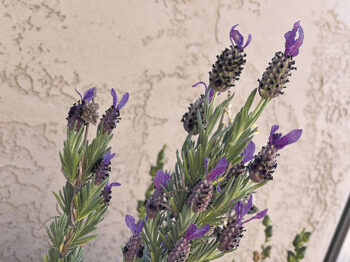 Dannette Hunnel
Dannette Hunnel
Lavender, a perennial semi-shrub, is a well-known, tough, pretty plant. With its unique green-grey leaf and lovely lavender-colored shoots, it’s easily recognized throughout our Valley. A lavender plant will look nice in a large container, along walkways, and mixed in a large flower bed—a welcoming site and aroma near the entrance of any home. Things to consider for lavender plant location: Bees really love lavender plants when they are in bloom. The fragrance attracts birds and butterflies, so lovely to watch. It’s great to smell the aroma, especially after a rain. A mature shrub size is approximately 2 to 3 feet high by 2 to 3 feet wide. While it’s famous scent is pleasing to many humans, the exact opposite is true for mosquitoes, flies, and fleas. And that’s a good thing!
With a starter plant, whether it’s a half-gallon single plant or a larger, one- to five-gallon potted shrub, dig that hole deep two times the width and the depth of the plant’s root ball with a spacing of two feet apart and when the weather is approximately 65 degrees or higher. Build a water basin, using your hand, about one inch deep around the plant. Water deeply at first so the water pools in the little basin, and keep the plant moist the rest of the first year. Lavender accepts a gravelly soil, so not a lot of soil mending or additives is necessary. In fact, lavender is native to the Mediterranean, and the soil there resembles Arizona soil, hence our state’s success with wine and olive growing, too.
Lavender tolerates the cold down to 25 degrees in the Phoenix area. Below that, it requires covering. Plant to avoid the western sunset, and with adequate water, lavender will take our yearly heat. Flowering will happen early spring through early summer. Plant food can be offered to your lavender in both spring and summer, but fertilizer isn’t needed. Mulch helps to keep your plant a little extra-moist throughout the year, and perlite mixed into the soil helps with better drainage. Lower leaves of yellow indicates too much water, so cut back. The plant requires a bit of pruning to remain healthy and blooming. It’s best to trim them annually in late summer after flowering has finished. Remove spent flower stalks and woody stems. Lavender does not have a very long life span compared to our other native desert plants, averaging only 7 to 10 years.
